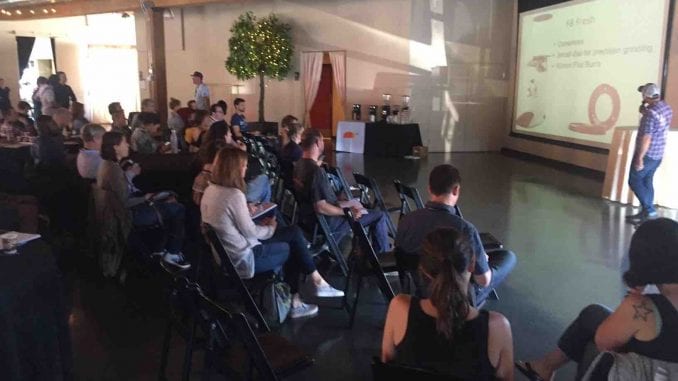
What’s the difference between conical and flat burrs? Compak encourages coffee pros to use taste to determine which produces a better cup.
Tracing the factors that make a coffee taste great can be difficult. Perhaps it’s a perfect roast that allows the flavors to shine, or maybe a well-calibrated espresso machine, or the way it’s processed. And everyone has their own opinions about what matters and what doesn’t based on a rumor learned from another barista, or perhaps misinformation read on the internet.
In their quest for knowledge, Compak decided to use the attendees of last week’s roasting competition and conference, The Golden Bean North America held in Portland, Ore., to test the differences between coffees ground on conical burrs versus flat burrs. In between the judging of different coffees from across the United States by leading North American roasters and QC managers, Compak hosted a workshop about the differences between conical and flat burrs and had the audience taste a range of coffees ground on an F8 Compak grinder (with 88mm flat burrs) and an E10 Master (with 68 mm conical burrs).

Often forgotten, the shape of the burrs, or the mechanism in grinders generally recognized by the coffee community as being superior to a blade to grind coffee, can affect how coffee tastes. Conical burrs have two cone-shaped plates that fit within one another and sit horizontally in the grinder; while flat burrs consist of two identical flat plates that sit on top of one another. Most grinder manufacturers make grinders with both types of burrs, and it’s difficult to make any definitive claims over which is better. œWe constantly are asked by baristas, roasters, and café owners about which will make their coffee taste better, Josh Fields, managing director for Compak America, said in an interview.

In the presentation, given by Tyler Duncan, lead trainer and educator for Topeca Coffee in Tulsa, Oklahoma, audience members weren’t simply given an answer, but asked to formulate their own opinions based on taste. œWe feel that data and empirical analysis is helpful in understanding which burr set might work best for one’s coffee, but we also believe that comparative taste analysis is too often ignored as an effective method of deciding taste preference, says Josh. Participants were asked to taste four espressos: an Italian Roast coffee from Topeca Coffee ground on both the F8 and E10, and a lighter roasted coffee, Topeca’s Signature Blend, ground on each ”and to then vote on which they liked best.

While there was a lot of variation, most people gravitated towards the lighter roasted coffee on the conical burr grinder. However, there was a fair amount of disagreement and many people voted for the other three options as their favorite brew. Instead of being discouraged by that amount of variation, Tyler and Josh were excited, they said, because it proved just how many variables need to be considered in conjunction with the shape of the burrs. œI think baristas and coffee professionals should know their roast style (i.e. light or dark roast), target taste profile, and customer tastes,” Josh expounded. “Then they should spend a bit of time not only cupping their coffees in the bean and roast evaluation, but also test their finished product on both a flat and a conical burr grinder. I believe it would be a revealing process for all. There is not simply one grinder or burr set that’s better or right, but instead a decision like which grinder to buy needs to be considered along with a host of other variables.

Overall, Josh says, œthe greater point ¦is taste preference. The workshop was not intended to prove one model better than the other, and has hopefully encouraged the coffee professionals in attendance to approach coffee decision-making with a mind to empirical, taste-based testing. You can find out more about the two grinders used in this experiment, and other models made by Compak on their website: www.compakgrinders.com.

About Ashley Rodriguez
413 Articles
Ashley is the Online Editor for Barista Magazine. She's based in Chicago. If you want to share a story or have a comment, you can reach her at ashley@baristamagazine.com.
Copyright 2025 Barista Magazine
